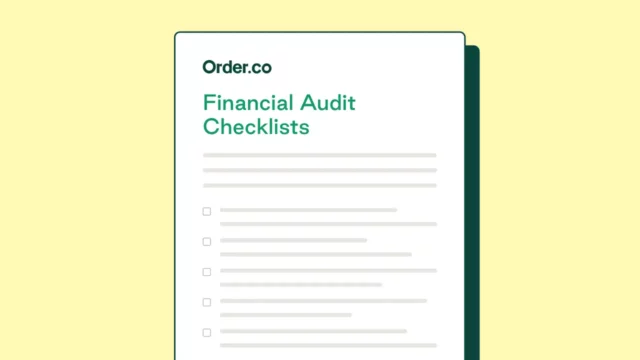Ace Your Next Financial Audit With These Preparation Tips

Ace Your Next Financial Audit With These Preparation Tips
The financial health of your company depends on accurate financial reporting. Even if everyone on your team follows procedures and calls out errors, getting fresh eyes on your data is the best way to get a clear view of your financial position.
That independent look is called a financial statement audit. While an audit might feel like it’s all about digging for problems, in reality, it’s more like a routine checkup for your financial data. Regular audits—at least yearly—ensure all your numbers and processes add up.
This article covers the basics of a financial audit, including:
- What a financial audit is
- How audits, reviews, and compilations differ
- The benefits of financial audits
- How software speeds and bolsters the audit process
Download the free tool: Financial Audit Preparation Checklist
What is a financial audit?
A financial audit is a detailed review of a company’s financial statements and accounts to confirm they're accurate and complete. During the process, a neutral external auditor combs through your financial records and supporting documents to make sure everything lines up and follows the appropriate accounting standards. Once they've wrapped up, they issue their official opinion—ideally confirming your historical data is clean, accurate, and worthy of guiding smart decisions.
What’s the difference between an audit, a review, and a compilation?
Not all financial reviews are the same. Depending on the level of detail you need, one type of financial reporting may be better than another.
- Audit: An audit is a formal, third-party look at your organization's financial statements and records. It verifies that your information is accurate and reliable and that it follows standards like Generally Accepted Accounting Principles (GAAP) or the International Financial Reporting Standards (IFRS).
- Review: A review analyzes the work of another auditor to confirm that reported information is true and that prior audits adhered to the proper standards. Reviews aren't as detailed as audits and may not include direct tests of accounting records. However, they still give you confidence in the completeness and accuracy of your reporting.
- Compilation: Compilations are appropriate when you need an accounting professional to organize your financial data without doing a full audit or review. A certified public accountant (CPA) collects and presents financial data in a compilation but doesn't analyze it.
Each of these methods helps you get a clearer picture of your finances so you can avoid negative impacts and reduce risk.
What’s the difference between accounting and auditing?
Accounting is the routine process of recording your company’s financial life. It follows strict standards (like GAAP) and provides the numbers your financial team relies on to do business.
Auditing is less frequent but more thorough and objective. It shows that your accounting policies are adequate and error-free by validating your financial statements. t (CPA) uses these sources to ensure a company’s statements about its financial position are reliable.
The 3 types of financial audits
There are three types of audits to consider based on what you’re looking for:
External audit: External audits are reviews completed by outside firms to prove your financial records are accurate and honest. Public companies often require these audits so investors trust the numbers and know you're following the rules.
Internal audit: An internal audit is when your own team checks how well your company is running. It reviews internal controls, risk management procedures, and governance processes to find ways you can do better.
Forensic audit: Specialized forensic audits help investigate suspected issues like vendor fraud or fishy financial activity. Since businesses lose an average of 5% of annual revenue to fraud, these expert investigations can be central to reducing risk.
Benefits of a financial audit
A financial audit gives companies, financial planning professionals, investors, and lenders peace of mind. It's a way to verify your records and improve your accounting processes so your business runs smoother.
Here are some reasons companies use audits:
Error detection: An audit checks how accurate your books are by comparing known financial data (like previous year totals, trial balances, duplicate payments, and other sources of verified data) to spot any issues. This process can reveal unusual patterns or numbers that don't add up.
Fraud prevention: During an audit, your auditor may review internal controls, such as who handles certain duties or approval processes. They'll look for changes in accounting estimates or incorrect requests for payment. While all audits can catch these types of problems, a forensic audit is your best bet if you suspect fraud.
Cost reduction: Audits highlight savings opportunities you might have missed. Material findings in an audit report can point out problems like cash leaks, miscategorized spending, and ledger entry issues that make it hard to see where your money's going.
Resource allocation: A financial audit can help you decide how to use available capital. It might reveal where you're spending too much or not enough so you can better align your budget with your goals.
External reporting: Investors and lenders need to know you manage finances well. A financial audit shows them your financial process and ability to repay. Order.co makes audits easier by bringing all your data together for cross-referencing and error-checking.
What do auditors review during a financial audit?
Your auditor may use these resources for drafting an opinion:
- Financial statements: Recent cash flow statements, balance sheets, and income statements that provide context for your other financial reports
- Account balances and transactions: Balances and transaction history for the period they're reviewing
- Historical documents: Your company’s founding paperwork, such as articles of incorporation and bylaws
- IRS documentation: IRS letters, memos, and documents, including exemption letters and returns
- Internal documents: Policies and procedures documentation, financial reporting processes, employee handbooks, and security documents
- Commitments: Financial promises you've made, like loans, lease agreements, employee benefits, and other liabilities
How to prepare for and conduct a financial audit
Audits don't have to be stressful. With the right preparation and an understanding of what to expect, they can actually help your business run better and save you money.
Getting ready for an audit
Audit planning takes time and attention, but with some upfront prep, it can be smooth and informative. Here are three steps to make the research and reporting process painless:
- Pull together financial information: Collect documents for the review period of the audit. Include:
- Trial balance info
- General ledger
- Book of accounts
- Financial statements
- IRS documents
- Supporting documents
- Gather internal documentation: Compile internal documents or process guidelines such as:
- Handbooks
- Accounting standards of practice (SOPs)
- Department manuals
- Company bylaws
- Finance operations policies
- Communicate with stakeholders: Discuss information and dates with external and internal parties, including:
- Auditors
- Finance team members
- Accounting team members
These info-gathering and communication steps create transparency and cooperation in your audit program. When everyone's on the same page from the start, you can address potential issues in the process before they become problems in the final report.
Walking through an audit's steps
While every audit is different, they all follow the same general process. Here are the four main steps auditors take to form their opinion:
- Planning and prep: The auditor reviews your business and industry, weighs risk, sets audit goals, and creates an audit strategy. They gather info about your internal controls and decide on the nature, timing, and depth of the audit they’ll run.
- Internal control evaluation: They then look at how well your internal controls work to find areas of high risk and lay out the best approach for the audit. They test your internal controls to make sure your financial roles are clearly defined and properly separated.
- Substantive testing: Next, the auditor gathers evidence about balances and transactions. To confirm your data is accurate and complete, they use substantive tests like transaction testing, analytical procedures, and physical asset checks.
- Conclusion and reporting: In the final step, the auditor writes out their assessment and compiles their findings into an audit report. They form their opinion on whether the financial statements present a true and fair view of your finances and make sure your records meet applicable accounting standards.
Once an audit is complete, the auditor shares their findings with management or a board of directors.
Common financial audit findings and how to address them
Audits are valuable tools for learning about your company’s financial health. However, the best way to get to a “no material findings” opinion is to start with clean and complete data, which requires visibility.
There are several common audit findings to look out for:
Missing documentation: Documentation and transactions should match up during an audit. When they don’t, it’s hard to verify accuracy. The audit may reveal that you need additional invoices, receipts, and contracts to back up your financial data. This is easier to round up if you use a document management system.
Inaccurate financials: Team members recording expenses in the wrong category can affect your financial statements. Review expense classifications and train your staff to follow correct accounting practices to avoid issues.
Unreconciled entries: Entries that don’t match different accounts or records create problems in your financials. In addition to reconciling accounts regularly, be sure to investigate any mismatches and correct them in the ledger.
Lack of internal controls: Not having enough separation between roles creates openings for mistakes or fraud. Dual control, when two or more agents of the business verify and record transactions, is essential for proper accounting practices.
Inadequate inventory controls: Knowing the amount and value of your business assets is key for good audit outcomes. Maintaining asset control to track inventory levels, values, and goods disposition can help your audits come back clean.
Getting ahead of these common issues means taking a proactive approach to managing your finances. This includes investing in team training and building better processes to keep everything accurate and compliant.
Use software to improve the financial audit process
Financial audits go much smoother when you can access centralized information on demand. With a procurement management solution like Order.co, finance teams can create a clear audit trail for every transaction. This gives auditors a detailed view of financial information, transaction data, support documentation, and journal entries.
Order.co keeps information from every origin in one secure place so your team can find what you need at audit time.
With Order.co, you get:
- Seamless invoicing that makes tracking historical expenses (and their impact on profitability) easy
- Integration with your accounting systems so you can review finances and prepare budgets
- Report delivery that lets you send financial reports to stakeholders in an easy-to-read format
See how these features simplify your audit process with a demo of Order.co.
Get started
Schedule a demo to see how Order.co can simplify buying for your business
"*" indicates required fields



